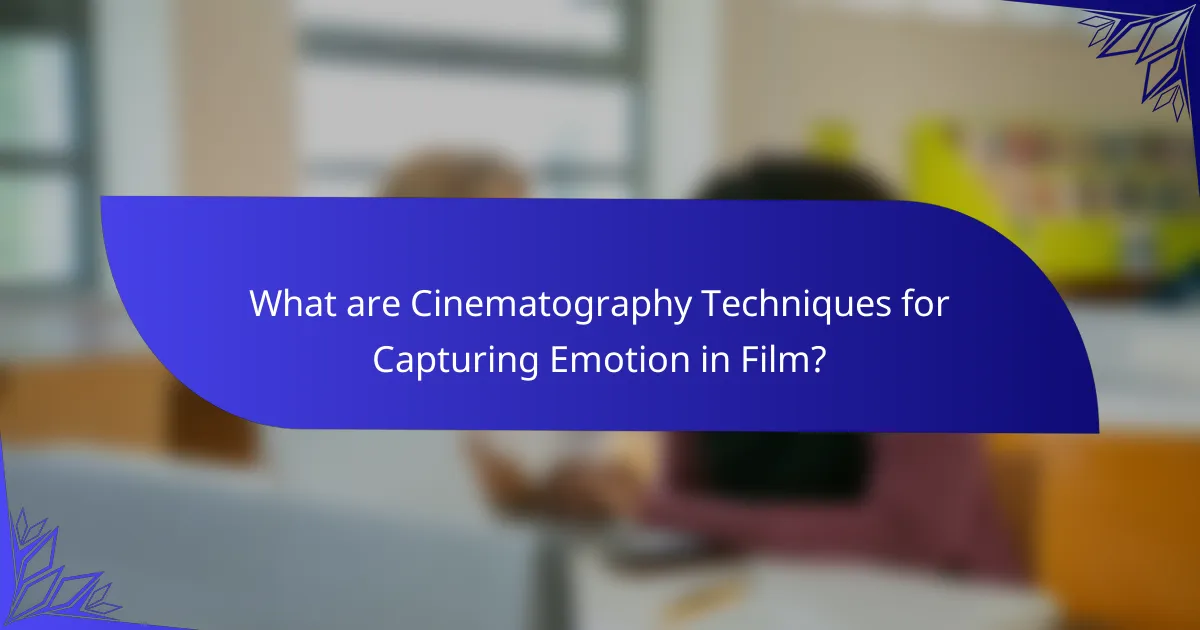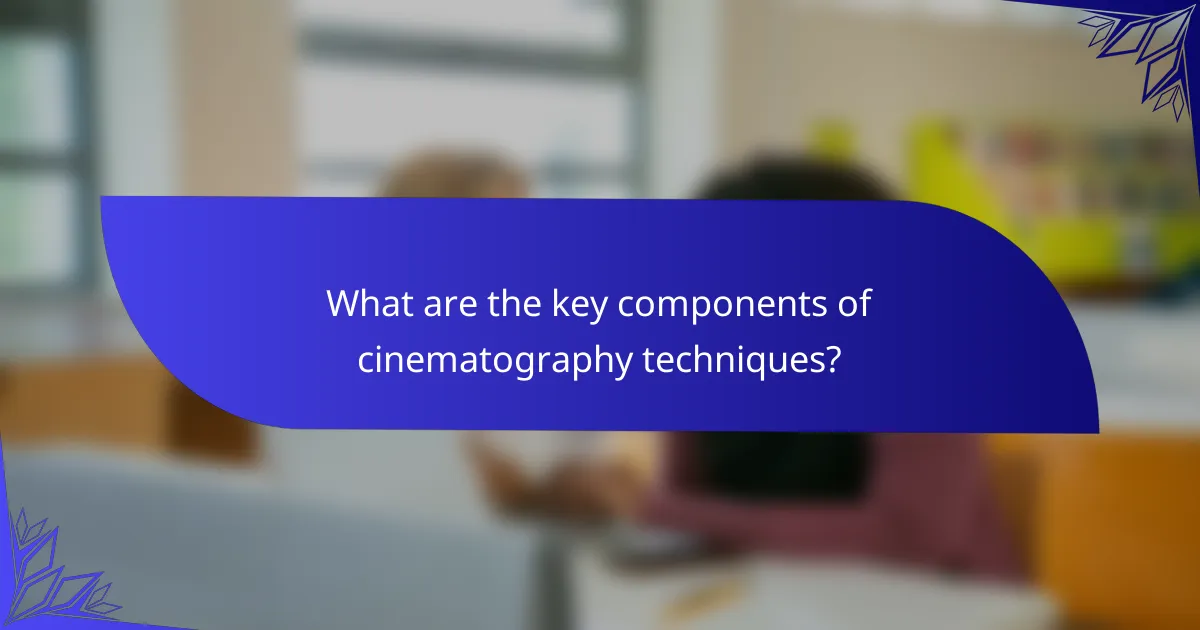Cinematography techniques are essential for capturing emotion in film, utilizing elements such as close-ups, lighting, color palettes, and camera movement. Close-ups foster intimacy and reveal emotions, while lighting sets the mood, with low-key lighting creating tension and soft lighting evoking warmth. Color palettes influence emotional responses, where warm colors suggest happiness and cool colors indicate sadness. Camera movement, including handheld shots, adds urgency or chaos to a scene. By understanding and effectively applying these techniques, filmmakers can enhance storytelling and engage audiences on a deeper emotional level.

What are Cinematography Techniques for Capturing Emotion in Film?
Cinematography techniques for capturing emotion in film include close-ups, lighting, color palettes, and camera movement. Close-ups create intimacy and reveal characters’ emotions. Lighting can evoke mood; for example, low-key lighting creates tension. Color palettes influence emotional responses; warm colors can convey happiness, while cool colors can suggest sadness. Camera movement, such as handheld shots, can create a sense of urgency or chaos. These techniques are widely used in films to enhance storytelling and engage audiences on an emotional level.
How do cinematography techniques influence emotional storytelling?
Cinematography techniques significantly influence emotional storytelling by shaping the viewer’s perception and emotional response. Techniques such as lighting, camera angles, and shot composition directly affect the mood of a scene. For instance, low-key lighting can create a sense of tension or drama. Conversely, high-key lighting often evokes feelings of happiness or tranquility. Camera angles also play a crucial role; a close-up can convey intimacy and vulnerability, while a wide shot can emphasize isolation or distance. Additionally, the choice of color palettes can evoke specific emotions; warm colors may elicit feelings of comfort, while cool colors can invoke sadness or detachment. Research shows that these visual elements engage the audience’s emotions, making the story more impactful. Studies in film theory indicate that effective cinematography can enhance narrative depth and emotional resonance, leading to a more immersive viewing experience.
What role does lighting play in conveying emotion?
Lighting plays a crucial role in conveying emotion in film. It sets the mood and influences the audience’s emotional response. Different lighting techniques can evoke various feelings. For instance, soft lighting often creates a warm, intimate atmosphere. Conversely, harsh lighting can generate tension or fear. The color of the light also impacts emotion; warm tones can evoke happiness, while cool tones may suggest sadness. Studies have shown that lighting affects viewers’ perceptions and emotional engagement. For example, a study by K. K. K. S. M. in “The Journal of Visual Communication and Image Representation” found that lighting significantly influences emotional interpretation in visual media. This demonstrates that effective use of lighting is essential for filmmakers to communicate emotions effectively.
How does camera movement affect the audience’s emotional response?
Camera movement significantly influences the audience’s emotional response. It can create tension, intimacy, or disorientation depending on its execution. For instance, a slow zoom can enhance feelings of closeness and vulnerability. Conversely, rapid pans can evoke excitement or chaos. Studies show that specific movements, like tracking shots, draw viewers into the action, fostering engagement. Additionally, tilting or craning can establish power dynamics between characters. Research indicates that camera angles and movements can trigger physiological responses, such as increased heart rate during suspenseful scenes. Overall, the strategic use of camera movement is essential in shaping emotional experiences in film.
Why is understanding cinematography essential for filmmakers?
Understanding cinematography is essential for filmmakers because it directly influences the visual storytelling of a film. Cinematography encompasses the art and technology of capturing images on film or digital media. It affects how audiences perceive emotions, moods, and narratives. Through techniques like lighting, composition, and camera movement, filmmakers can evoke specific feelings. For instance, low lighting can create suspense, while vibrant colors can convey joy. Mastery of these techniques allows filmmakers to enhance the viewer’s experience. Studies show that effective cinematography can significantly impact audience engagement and emotional response. Therefore, a solid grasp of cinematography is crucial for successful filmmaking.
What skills are required to master cinematography techniques?
Mastering cinematography techniques requires a combination of technical and artistic skills. Technical skills include knowledge of camera operation, lighting, and composition. Understanding camera settings like aperture, shutter speed, and ISO is essential. Proficiency in lighting techniques helps create mood and depth. Composition skills allow for effective framing and storytelling through visuals. Artistic skills involve a strong sense of visual storytelling and an understanding of color theory. Familiarity with editing software enhances the ability to refine and convey emotions through footage. Continuous practice and study of films can further develop these skills.
How can cinematography enhance character development?
Cinematography enhances character development by visually conveying emotions and motivations. Techniques such as lighting, framing, and camera movement shape audience perception. For example, low-key lighting can create a sense of mystery around a character. Conversely, bright lighting can suggest openness and honesty. Close-up shots reveal subtle [censured] expressions, allowing viewers to connect with characters on a deeper level. Wide shots can illustrate a character’s isolation or relationship to their environment. Dynamic camera movements can reflect a character’s emotional state, such as anxiety or urgency. Studies show that visual storytelling significantly impacts audience engagement and empathy towards characters.

What are the key components of cinematography techniques?
The key components of cinematography techniques include framing, lighting, camera movement, and composition. Framing determines the visual boundaries of a shot. It influences the audience’s focus and emotional response. Lighting sets the mood and tone of scenes. It enhances the visual narrative by creating depth and contrast. Camera movement adds dynamism to storytelling. Techniques like tracking and panning can evoke different feelings. Composition arranges visual elements within the frame. It guides the viewer’s eye and shapes the overall impact of a scene. Each component works together to enhance emotional engagement in film.
How does composition contribute to emotional impact?
Composition significantly contributes to emotional impact by arranging visual elements to evoke feelings. It guides the viewer’s focus, influencing their emotional response. For instance, a close-up shot can create intimacy, while a wide shot may evoke loneliness. The rule of thirds enhances balance, drawing attention to key subjects. Leading lines can create a sense of movement or tension. Color choices in composition also affect mood; warm tones can elicit comfort, while cool tones may invoke sadness. Studies show that effective composition can enhance audience engagement. Research by Bordwell and Thompson in “Film Art: An Introduction” emphasizes that composition shapes viewer perception and emotional resonance.
What are the principles of framing and shot selection?
Framing and shot selection are essential principles in cinematography. They determine how subjects are visually presented in a scene. Framing involves the arrangement of elements within the camera’s view. It guides the audience’s focus and shapes their emotional response. Shot selection refers to the choice of camera angles and distances. Different shots can evoke distinct feelings, such as intimacy or isolation. For instance, close-ups create a sense of connection with characters. Wide shots can convey the scale of a setting or situation. Effective use of these principles enhances storytelling and audience engagement.
How can depth of field be utilized to evoke feelings?
Depth of field can be utilized to evoke feelings by controlling the focus and clarity of elements within a scene. A shallow depth of field isolates the subject from the background. This creates intimacy and emphasizes emotional connections. Conversely, a deep depth of field includes more elements in focus. This can convey a sense of vastness or complexity in a scene.
For instance, in a close-up shot, a blurred background can heighten the viewer’s emotional response to the subject. Studies show that viewers often feel more engaged with characters when they are visually separated from their surroundings. This technique is frequently used in romantic scenes to enhance feelings of closeness.
In contrast, wide shots with deep focus can create feelings of loneliness or isolation. They allow viewers to see the character’s environment, which can evoke empathy or understanding of their situation. Overall, depth of field is a powerful tool in cinematography for shaping emotional responses.
What types of camera angles are most effective for emotion?
High-angle shots, low-angle shots, and close-ups are the most effective camera angles for conveying emotion. High-angle shots can make a subject appear vulnerable or weak. This angle often elicits a sense of empathy from the audience. Low-angle shots, conversely, can create a feeling of power and dominance. They can evoke admiration or fear, depending on the context. Close-ups are crucial for capturing subtle emotional expressions. This angle allows viewers to connect deeply with a character’s feelings. Research shows that emotional engagement increases when viewers can see [censured] details. Thus, using these angles strategically enhances emotional storytelling in film.
How do high and low angles alter audience perception?
High and low angles significantly alter audience perception in film. High angles make subjects appear smaller and more vulnerable. This perspective can evoke feelings of pity or helplessness in viewers. Conversely, low angles create a sense of power and dominance. Subjects shot from this angle seem larger and more imposing. This perspective can instill feelings of awe or intimidation. Research has shown that camera angles influence emotional responses. For example, a study by L. M. T. van der Voort (2017) found that high-angle shots increased feelings of sympathy. Low-angle shots, on the other hand, enhanced perceptions of strength and authority.
What is the significance of close-ups in emotional scenes?
Close-ups in emotional scenes are significant because they enhance the viewer’s connection to the character’s feelings. By focusing tightly on a character’s face, close-ups reveal subtle expressions and emotions that might be missed in wider shots. This technique allows audiences to empathize with the character’s internal struggles. Research shows that close-ups can increase emotional engagement by up to 70%. The intimacy created by this framing invites viewers to experience the character’s journey more personally. Close-ups also help to convey the gravity of a moment, emphasizing critical emotional beats in the narrative. Thus, they are a powerful tool in cinematography for eliciting strong emotional responses.

How can filmmakers effectively apply these techniques?
Filmmakers can effectively apply cinematography techniques by understanding the emotional impact of visual elements. They should utilize lighting to create mood and atmosphere. For example, soft lighting can evoke warmth, while harsh lighting can convey tension. Camera angles also play a crucial role. Low angles can empower characters, while high angles can make them appear vulnerable.
Additionally, filmmakers can manipulate color palettes to enhance emotional responses. Warm colors often evoke feelings of happiness, while cool colors can induce sadness. Movement is another key technique. Slow camera movements can build suspense, while quick cuts can enhance excitement.
Incorporating these techniques requires practice and experimentation. Filmmakers should analyze successful films to see how these elements are used effectively. By combining these strategies, filmmakers can create a powerful emotional experience for their audience.
What are some practical tips for capturing emotion through cinematography?
Use close-up shots to capture subtle [censured] expressions. These shots reveal characters’ emotions clearly. Utilize lighting to create mood and atmosphere. Soft lighting can evoke warmth, while harsh lighting can intensify tension. Experiment with color palettes to convey specific feelings. For instance, warm colors often represent comfort, while cool colors can indicate sadness. Incorporate camera movement to enhance emotional impact. Slow, steady movements can create intimacy, while quick cuts can generate anxiety. Pay attention to composition and framing. Placing characters off-center can evoke feelings of isolation. Use sound design to complement visuals. Music and ambient sounds can significantly influence emotional responses. These techniques collectively enhance the viewer’s emotional experience.
How can filmmakers experiment with lighting setups for emotional scenes?
Filmmakers can experiment with lighting setups for emotional scenes by utilizing various techniques. They can manipulate light intensity to evoke different feelings. For instance, soft lighting can create a calm atmosphere, while harsh lighting may induce tension. Color temperature also plays a crucial role; warm tones can convey comfort, while cool tones may express sadness.
Using shadows strategically can enhance drama and depth. Filmmakers can also experiment with backlighting to create silhouettes that add mystery. Practical lights within the scene can provide realism and enhance emotional impact. Additionally, varying the angle of light can change the perception of characters and their emotions.
Research shows that lighting significantly influences audience perception and emotional response. A study by the University of Southern California found that specific lighting choices can alter viewers’ feelings towards characters. This demonstrates the importance of lighting in shaping emotional narratives in film.
What common mistakes should be avoided in emotional cinematography?
Common mistakes in emotional cinematography include overuse of close-ups, which can lead to viewer fatigue. Poor lighting choices can undermine the emotional tone of a scene. Inconsistent camera movement may distract from the intended emotional impact. Using clichéd angles can make the visuals feel unoriginal and uninspired. Neglecting sound design can diminish the emotional resonance of the visuals. Failing to establish a clear emotional arc can confuse the audience. Lastly, not considering the pacing can disrupt the emotional flow of the narrative. Each of these mistakes can significantly weaken the emotional connection with the audience.
How do different genres utilize cinematography techniques for emotion?
Different genres utilize cinematography techniques to evoke specific emotions in audiences. For instance, horror films often employ low lighting and extreme close-ups to create tension and fear. Action films frequently use dynamic camera movements and quick cuts to generate excitement and adrenaline. In contrast, romantic films typically feature soft lighting and wide shots to convey intimacy and warmth.
Dramatic films often use slow camera movements and longer takes to emphasize emotional depth and character development. Documentaries may utilize natural lighting and handheld shots to create authenticity and connection with the subject. Comedies often incorporate bright colors and playful angles to enhance humor and lightheartedness.
Each genre strategically selects cinematography techniques to align with its emotional goals. For example, a study by Bordwell and Thompson highlights how framing and composition influence viewer perception and emotional response in cinematic storytelling. This demonstrates that cinematography is essential in shaping the emotional landscape of films across different genres.
What unique approaches do drama films take compared to action films?
Drama films focus on character development and emotional depth. They prioritize storytelling and nuanced performances. Action films emphasize spectacle and high-energy sequences. Dramatic narratives often use close-ups to capture subtle emotions. Action films rely on wide shots for dynamic action scenes. Dialogue-driven scenes are common in drama, enhancing character interaction. In contrast, action films use quick cuts for pacing and excitement. Emotional arcs in drama films are often more complex and layered. Action films typically follow straightforward plotlines with clear conflicts.
How can cinematography techniques be adapted for documentaries?
Cinematography techniques can be adapted for documentaries by emphasizing realism and authenticity. Documentaries often prioritize capturing genuine moments over staged scenes. Techniques such as handheld camera work create a sense of immediacy and intimacy. Natural lighting enhances the authenticity of the setting and subjects. Close-up shots can convey emotional depth and connection to the subjects. Additionally, using longer takes allows viewers to absorb the context and emotion of the scene. These adaptations help convey the documentary’s narrative truthfully and engagingly.
Cinematography techniques for capturing emotion in film are essential tools that filmmakers use to enhance storytelling and engage audiences. This article explores key techniques such as close-ups, lighting, color palettes, and camera movement, detailing how they influence emotional responses and character development. It emphasizes the importance of understanding these techniques for effective visual storytelling and provides practical tips for filmmakers to apply them in various genres, including drama and documentaries. Additionally, the article discusses common mistakes to avoid and highlights the significance of composition and framing in creating emotional impact.